With the Comic Code Authority’s giant switch in regards to LGBTQ+ content, things changed pretty immediately in the industry — instead of being forbidden, or being considered “adult” suddenly queer issues and queer stories were an untapped wellspring of fresh plot ideas.

Andy Lippincott returned to Doonesbury in 1989. While the character had appeared off and on since his introduction in 1976, this time he became a staple of the strip — appearing pretty frequently over the course of the next year. The story arc began with Andy’s friend, and one of the main characters of the strip, Joanie Caucus learning that Andy was in the hospital with AIDS. Over the next year, the comic would revisit Andy — touching on the stigma of the disease, the stigma of homosexuality, the medical community’s confusion over the disease’s unpredictability, the difficulty of getting into experimental treatments, and many other topics and issues facing AIDS patients. 900 newspapers carried Doonesbury at the time. Only three of them refused to publish this story arc, saying it was “in bad taste.” But for readers of those other 897 newspapers, all over the country, it brought the very real tragedy that so much of the LGBTQ+ community was dealing with into their homes every day. And then, finally, on May 24th, 1990, Andy Lippincott became the first comic character to die of AIDS complications. I gotta tell you, I read his whole arc in researching this article and I cried. I read it all at once, which….I don’t recommend. Give yourself a little time in between the strips, okay? But its understandable that people had an emotional reaction, and some people were galvanized to take action. Garry Trudeau received a Pulitzer Prize nomination for the story arc (well deserved, in my opinion). In Doonesbury, Andy Lippincott has a panel for the AIDS Memorial Quilt. A real panel was created by G. Scott Austen, Marceo Miranda and Juan-Carlos Castano which hangs in the NAMES Project Foundation’s offices (rather than being sewn into the actual quilt itself.) As far as I know, he is the only fictional character to have a panel in their honor.



With the Code having reversed its position on gay people, Marvel decided that 1990 was the year they were going to have someone with superpowers really actually come out in the pages of their comic books! So, at the end of Captain America #368 they included a short story in which the Machinesmith revealed that he was gay! But only for male robots like Vision (which is fine because Machinesmith has put his mind in a robot body himself.) But then again, like, we saw Vision in Wandavision and I’m kind of on board with Machinesmith for that one. Except that he was evil at the time which is how they justified the events of Avengers #325, wherein Machinesmith manages to knock Vision unconscious and has his way with him. However robots do that. And later his villainous cohorts find him spooning with the unconscious android. So, just to recap, Marvel’s first super-powered truly openly gay character is an evil robot and a rapist. What were you thinking, Marvel?
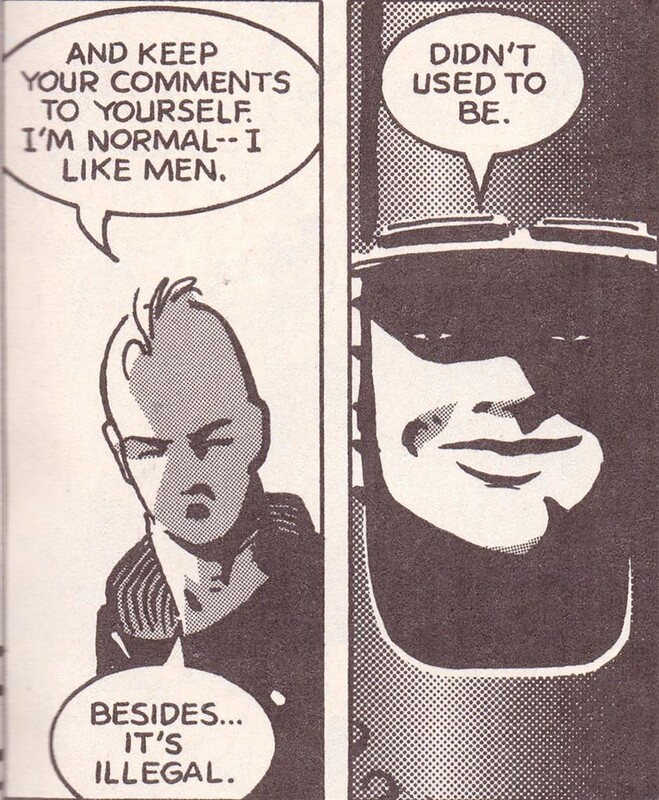
Marvel wasn’t the only kind of missing the mark when it came to positive LGBTQ+ representation that year. Around this time Dark Horse Comics was making waves, having steadily grown for years. In Dark Horse Presents #40, they began a story set in a dystopian future where homosexuality had taken over and heterosexuality was criminalized. It was making a really valid point, but still didn’t exactly paint gay people in the best possible light. The story was never finished. Still, there was worse happening that year. Mark Millar, in his first published work, wrote a series called Saviour for Trident Comics — the lead character was the antichrist and he was not above raping men. In particular, a priest (who he promptly also murdered.) Millar would go on to be a really significant comic book creator for both DC and Marvel, and some of his works for other companies are now successful movie franchises, like Kingsman and Kick-Ass. Rick Veitch self-published a limited series called Brat Pack, a really dark satire of mainstream comic books, sort of akin to Watchmen in some ways but like….worse. In it, the Batman analog Midnight Mink was a flamboyant gay man who sexually abuses his sidekicks. But never fear, because DC Comics would not let us down, giving an emotional moment to The Brain in Doom Patrol #34, when he confesses his love for Monsieur Mallah before his body promptly exploded. Okay, they’re villains, but it was still a heartfelt moment.

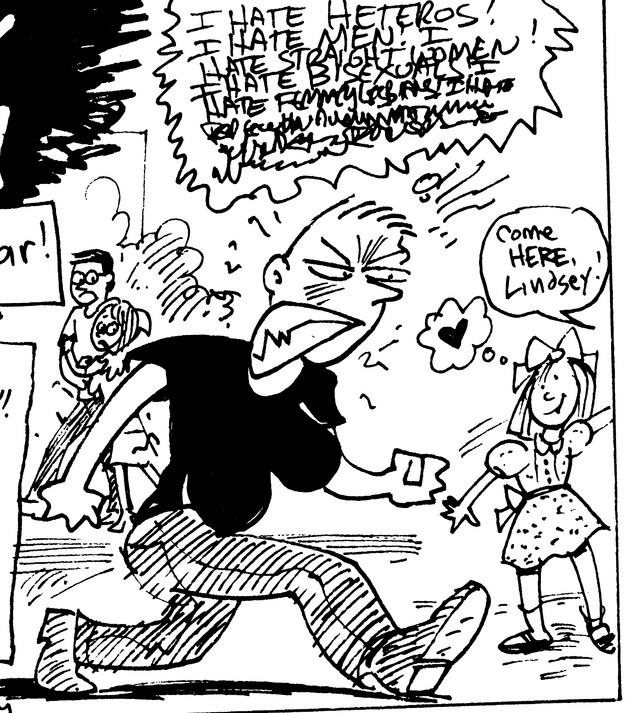
In 1991, LGBTQ+ people pretty much cornered the market when it came to telling queer stories in comics. Roberta Gregory created her landmark character Bitchy Bitch for the series Naughty Bits — accompanied shortly thereafter by a lesbian character named Bitchy Butch. Robert Kirby began publishing his long-running series “Curbside” in various LGBTQ+ newspapers and magazines, and released the first issue of his antholoy Strange Looking Exile. Celebrated German cartoonist Ralf König had the first of his work — Kondom des Grauens (or, translated, The Killer Condom) — translated into English in this year and released in the United States and in Canada. Diane DiMassa published the first twenty issues of Hot Head Paisan: Homicidal Lesbian Terrorist. That series would continue running until 1998, and was described (on Wikipedia) as “rage therapy for the marginalised.”
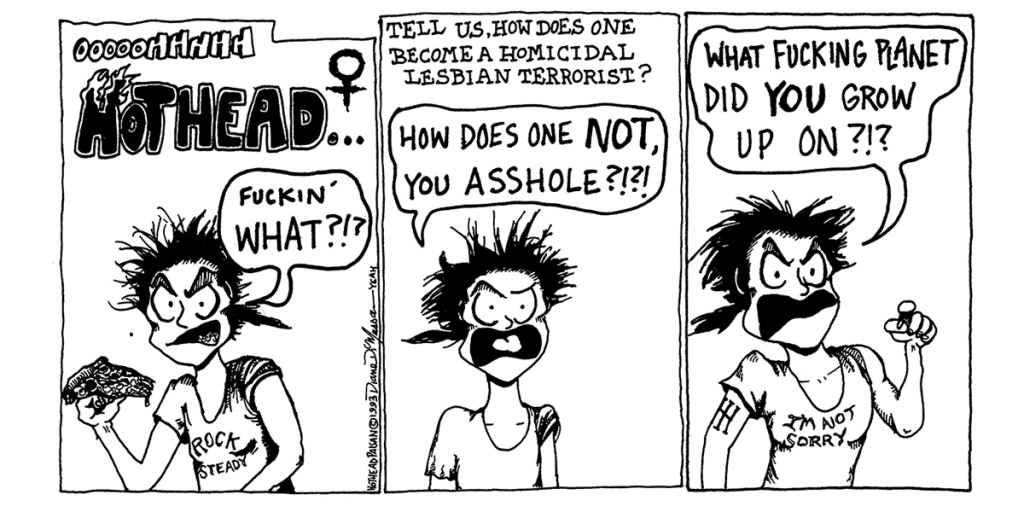
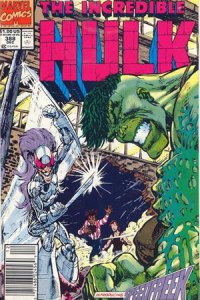
By this point, you may have noticed, Marvel Comics was clearly falling behind when it came to LGBTQ+ representation. I mean, DC has more queer characters than I can count on one hand and has even tackled gender dysphoria (twice). But they were starting to get it — in December of 1991, in The Incredible Hulk #388, dealing with Tyler Lang‘s AIDS diagnosis. Lang’s father is a mob boss, who hires the supervillain Speedfreek to kill his son’s lover, Jefferson Wolfe for infecting him. Over the course of the book, it was revealed that major recurring character Jim Wilson — a friend of the Hulk and the nephew of Sam Wilson (better known as the Falcon, who MCU fans should recognize) — was HIV positive and managing an AIDS Clinic. Tyler Lang became the first Marvel character to die of AIDS complications in that issue. (Jim Wilson would ultimately meet the same fate three years later.)
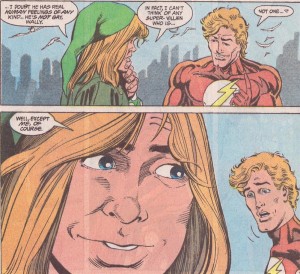
DC comics spent that year fully embracing the new Code rules regarding LGBTQ+ characters by first having the former supervillain Pied Piper come out as gay in the opening pages of The Flash (vol. 2) #53 — which would win the first ever GLAAD Media Award for Outstanding Comic Book the following year, despite it really having nothing at all to do with the main story of the issue. Neil Gaiman’s Sandman series — published by DC’s Vertigo Comics — went on to introduce three queer characters, including Wanda Mann, a transgender woman. They kept that trend going in 1992 putting the reformed villain Lightning Lord in a gay relationship, and implying that the heroic duo Shrinking Violet and Lightning Lass were a couple, and Justice League Quarterly #8 casually mentioned that Tasmanian Devil was gay (not the Looney Tunes one, I know you were thinking it) by having him express how accepting the team was. In Hellblazer #51, John Constantine — the lead character of the longrunning series — casually mentioned that he’d had “the odd boyfriend” — the first official reveal of his bisexuality. They also did a whole story arc to finally deal with the rumors that had been circulating for decades about their character Element Lad and his romance with Shvaughn Erin by having it turn out that Shvaughn was a transgender woman, who had transitioned with the help of a sci-fi drug called “ProFem”. With this revelation, Element Lad declared that what they’d had together was “in spite of the ProFem, not because of it.” Because alien invasion interrupted the supply of ProFem, Shvaughn was forced to de-transition but the two stayed a couple. (Until DC rebooted their entire universe and retconned virtually everything about these two characters, but that’s beside the point.)


Marvel’s Northstar officially, finally came out in the page of Alpha Flight #106 in 1992! This was actually a pretty big deal, it even though everyone had already known for years. Seriously. If there was ever a superhero I would not trust to keep a secret…. Anyways, the plot, essentially, is that Northstar — in his public persona as a former Olympian — adopted a baby named Joanne, who had AIDS. This garnered a great deal of public sympathy. This made Major Mapleleaf (the Canadian version of Captain America, who was never in a comic before this and….) pretty mad because his gay son had died of AIDS and been blamed for it, because of the stigma surrounding both AIDS and gay people. So Major Maplelead attacked the hospital Joanne was in, quickly coming to blows with Northstar — venting his frustration during the fight. So, Northstar says he knows the hardships gay people face, since he is gay….and that makes Major Mapleleaf even angrier because Northstar isn’t using his fame to help gay people or act as an AIDS activist. The issue received a ton of acclaim from the LGBTQ+ community for tackling the AIDS crisis so well, dealing with HIV stigma and homophobia simultaneously, and finally getting Northstar out of the closet. They did a lot. And it just goes to show that when Marvel is trying they can do actually great LGBTQ+ representation! If you want to read the Major Mapleleaf fight sequence for yourself, I found it on Imgur here.
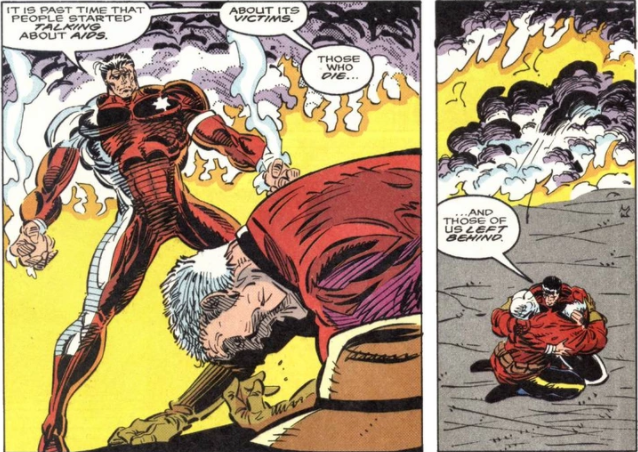
So, while this was all happening, the sci-fi TV show Quantum Leap was having additional “episodes” published as comic books. Andy Mangels wrote the ninth of these, published early in 1993, in which the lead character Sam Beckett leapt into the body of a lesbian photographer in New York City, in June of 1969. You know where this is going right? The issue touches on almost everything happening in NYC leading up to the Stonewall Riots — police corruption, mob run gay bars, Andy Warhol, Judy Garland — and leaves off right before the police raid begins. Quantum Leap, on television, had handled queer characters before (in fact, the lesbian photographer was a character in one of the TV episodes) this issue did not shy away from getting political. You can actually read the issue online for free here.
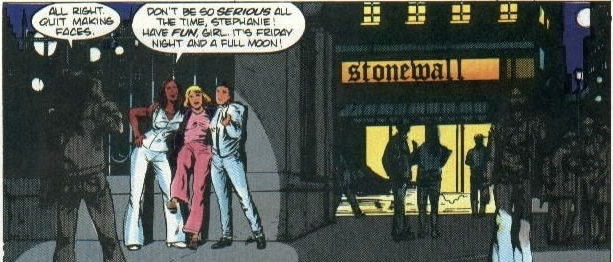

In March of 1993, Lynn Johnston’s syndicated comic strip “For Better or For Worse” — running in daily newspapers since 1979 — began a story in which long-running character Lawrence Poirier came out of the closet, becoming the first openly gay teenager and first gay person of color (as his father is Brazilian) in a syndicated newspaper comic strip. The story was inspired partially by the murder of Johnston’s friend Michael Boncoeur. Lawrence’s coming out was a four week set of strips, in which — to briefly summarize — he comes out to his friend Michael, then to his family, is rejected by everyone and then when he goes missing (after getting thrown out of his house), they all go looking for him, and in the end everyone comes around to accepting him for who he is. It’s pretty sad, until the end of the arc which is a much more upbeat ending than a lot of gay kids find with their families and friends even now. I think part of the hope was that by showing it in the strip, it might inspire some parents to come around to accepting their own kids. The publisher, Universal Press, was fully on board with the story, but when it was sent out to the various newspapers who ran the strip forty of them refused to run it. The response to the strip was overwhelming, and powerful — and much more negative than what I’ve read that Andy Lippincott’s reception was (perhaps because Doonesbury is inherently political and tends to lean to the liberal side of things?). Newspapers had to install new phone systems to handle the volume of calls, and Johnston began to be inundated with hate mail — including death threats. Nineteen papers stopped running “For Better or For Worse” altogether. Papers who were running the strip were attacked for it, and papers that refused to run it were accused of censorship. Within a couple of weeks, however, the tide changed — Johnston began receiving heartfelt letters of gratitude from the LGBTQ+ community. By the time the “coming out” story had finished, and the letters she’d received were sorted, more than 70% of the feedback Johnston received was positive.

In other comic strip news, one of the four leading characters of Doonesbury, Mark Slackmeyer, also came out of the closet as a gay man in that year. Rock ‘n Roll Comics #62 included a biography of Elton John — and by this point, there is so much LGBTQ+ themed work appearing in underground comics, I can’t even cover it all or this series will go on for forever. (Some of you probably already think it’s too long!) I just have to start hitting the highlights. But the biggest news of the year — for queer people anyways — was not actually in what was published, but what was won. The Comic Creators Guild awarded Gay Comics (formerly Gay Comix) its Best Anthology Award. After years of circulation, that bit of recognition was a big deal.

In comic books, Marvel gave the first-in-mainstream-comics explanation of the difference between sexuality, gender, and cross-dressing in Nomad #11, when the main character got into drag to investigate a series of murders in which the victims were all cross-dressers. Once again, Marvel goes to show that they can handle the queer stuff pretty deftly if they feel like it.
At the same time, under its Vertigo brand, DC was giving the gays everything. They created a mini-series called Sebastian O, the lead in which was basically a gay James Bond (and I don’t know about you but I’m dying for the film adaptions!) In Enigma #4, the Enigma entity awakened the latent homosexuality of its host Michael Smith — it was only an eight-issue series but it was still the lead character for the series grappling with his own sexuality. And then, just to confirm they had not been playing around by John Constantine’s casual coming out, in Hellblazer #69 depicts Constantine sharing a bed (well, a mattress on the floor) with a male prostitute. In Milestone Media — which published and distributed its comic books through DC — superhero Fade was outed by a telepathic supervillain in Blood Syndicate #8 — making him the first black gay superhero by a mainstream comic book publisher, even though he never really embraced who he was.
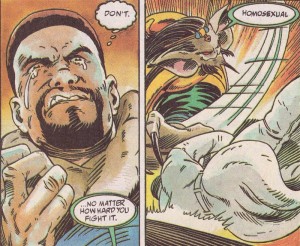

However, arguably DC’s most important queer character of the year was one we now often overlook — Coagula, who became a recurring character on Doom Patrol until about 2002. Coagula was the first transgender superhero (because Shvaughn Erin is technically not a superhero, she’s a just a regular cop), which she’d gotten her powers while working as a prostitute on the streets, after being hired by Doom Patrol’s Regis. She had first applied to join the Justice League and been rejected — something that seems to fly against previous statements by the Tasmanian Devil about how open-minded that group was. Whatever the case may be, she ended up joining the Doom Patrol and stayed with them until her death in 2002. But the most important thing about Coagula is her creator, Rachel Pollack — the first openly transgender writer to have worked for DC Comics. There have only been four others. The series Blood Syndicate would sort of reveal in their tenth issue that their shapeshifting character Masquerade was a transgender man, but they were just a few months after Coagula’s introduction.
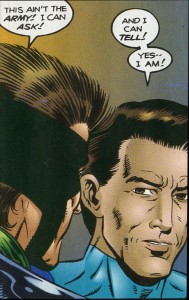
One last important queer comics moment in 1993 that I wanted to touch on was when Malibu Comics Entertainment offered us a pretty harsh critique of the Don’t Ask, Don’t Tell policy three months before the Clinton administration enacted it, in The Strangers #5, in which the character Spectral comes out to the rest of the superhero team. They’re immediately accepting. (This also made Spectral the first gay character for Malibu Comics but since they were only going to be around another year before being absorbed into Marvel and basically forgotten, that’s kind of incidental.)

In 1994, a piece of anti-gay legislation appeared in the state of Washington. In order to combat it, Hands Off! Comics by Over 35 Artists Collected to Fight Discrimination and Homophobia! was published with all proceeds donated to Washington Citizens for Fairness. Advice columnist Dan Savage also took that year to dabble in comics, releasing two issues of Savage Love. The idea of gay superheroes took hold in underground comics, with Go-Go Boy by Neil Johnston and Leatherboy by Craig Maynard both being released.
In Marvel’s New Warriors #48, a time-traveling Justice would discover that his father — up to this point painted as a pretty unsympathetic abusive father character — was a closeted homosexual. And while that could have been dealt with really terribly, instead it was dealt with really compassionately, with Justice starting to come to terms with who his dad is and why. It’s kind of touching, but it doesn’t come close to what Marvel was gonna do next.
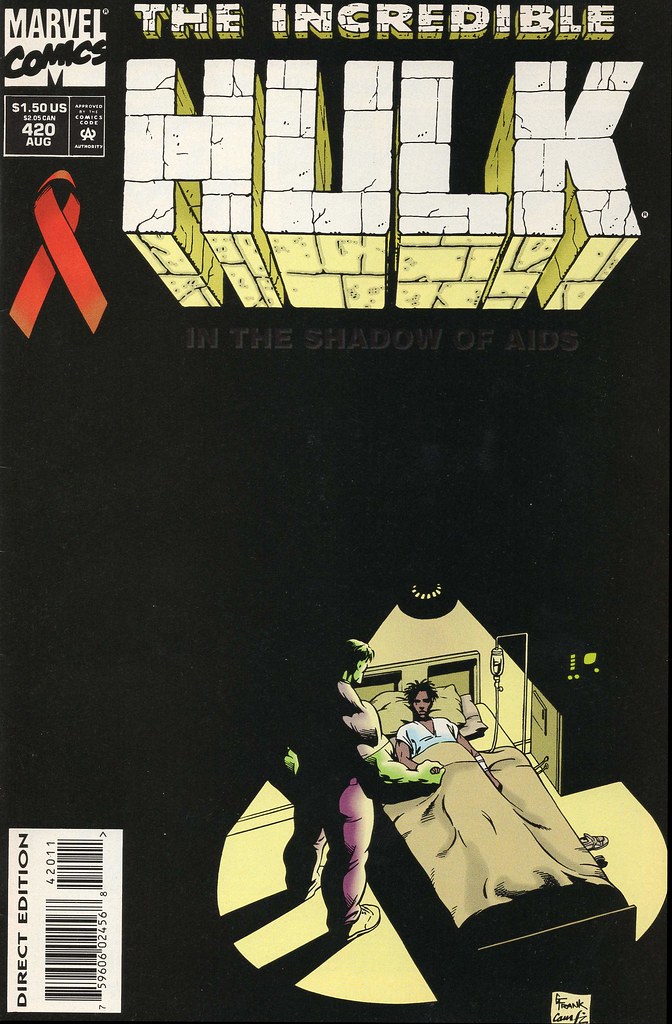
In The Incredible Hulk #417, Hector came out as gay and talked about how it wasn’t his choice. This set off an interesting relationship with his teammate Ulysses, who was homophobic. This would become particularly relevant later in the year when the two came to blows during The Incredible Hulk #420 — that issue revisited Jim Wilson’s AIDS in what is generally considered one of the best issues of the series. Aside from Jim’s storyline and ultimate death to AIDS complications (after being caught up in some violence at a protest over a student being expelled from school for being HIV positive), there’s a subplot wherein Betty Banner (the Hulk’s wife) tries to convince a straight white guy who’s just been diagnosed with HIV not to commit suicide — and she fails. Comic books often included letters from the fans at the end, but this issue instead had a number of comic book creators write a little bit about their own experiences with AIDS (all of which are in this really great article about the issue). The issue’s cover was used as an HIV awareness poster, so there’s a good chance you might recognize it even if you’ve never read it.


If it seems like DC was slacking off that year…well, not really. In the miniseries Fighting American, in which they were pretty blatantly parodying Captain America, they had their main character pursuing a relationship with a woman named Mary who turned out to be lesbian in the last issue. Shadow Cabinet revealed two of its female superheroes, Donner and Blitzen, were together, and in Static #16, the main character’s best friend Rick Stone came out after surviving a brutal gaybashing at the hands of white supremacists. The series The Invisibles introduced Lord Fanny, a transgender shaman from Brazil. The series Deathwish began, and one of the leads of the series was Marisa Rahm a transgender woman serving on the police force. Perhaps more notable is that Deathwish was written by Maddie Blaustein — a transgender woman herself, although she hadn’t changed her name yet. (Fun fact: Maddie also voiced Meowth on the first eight seasons of Pokémon.)

In 1995, the Atlanta AIDS Survival Project began including the strip “HIV + ME” by Chris Companik in their newsletter, which carried on into 2011. Kitchen Sink Press released….I mean just the most delightfully sacrilegious comic in Taboo #8, in which Jesus Christ and Lucifer have a philosophical debate that leads them to understand they have a lot in common. And then they kiss. The book was a collaborative effort between two openly gay creators P. Craig Russell and David Sexton, both of whom are fairly big in the comic industry.


That year would also see even more gay superheroes — Malibu Comics, recently acquired by Marvel, wrote superhero Turbocharge coming out in Prime (vol. 1) #21, becoming the first gay teenage superhero in mass produced comics. In Gen 13 (vol. 1) #2 by Image Comics, Native American superhero Rainmaker came out as bisexual. In DC’s Black Lightning (vol 2) #5, the hero Jefferson Pierce learned that his recently killed co-worker Walter Kasko was gay. Howard Cruse, best known so far for underground work, published a historical graphic novel called Stuck Rubber Baby for DC Comics, which dealt with the intersectionality of race and sexuality during the Civil Rights Movement. DC also released Chiaroscuro: The Private Lives of Leonardo Da Vinci, a biography of Leonardo Da Vinci that left in all the juicy gay parts that usually get dropped. They also gave Maggie Sawyer her own series — despite not being a superhero herself — called Metropolis S.C.U. — which was the first time a lesbian character was the lead in a mass produced comic book series that lasted for more than one issue (for which they would be awarded the GLAAD Outstanding Comic Award).

In 1996, DC, under their Vertigo Comics brand, published the autobiographical graphic novel 7 Miles a Second by David Wojnarowicz — four years after his death from AIDS. The book told his entire journey, not shying away from anything — from working as a teen prostitute, to his drug use, to his struggle with HIV — and especially his anger with the government for ignoring the epidemic. The call out of the government itself in a comic book is particularly significant. That same year, in the pages of Justice League of America #110 and #111, two different team members (Obsidian and Ice Maiden) told Nuklon about their queer sexualities. Just a couple of months later in DC’s series The Spectre (#45) in a story called “Acts of God”, the Spectre (and his alter-ego Jim Corrigan) learned to overcome his own homophobia and stand up against anti-gay violence being done in the name of religion. That story was nominated for a GLAAD Outstanding Comic Award, but lost to Neil Gaiman’s Death: The Time of Your Life — also published by DC. That miniseries follows a lesbian couple in which one is a popular musician on tour, tackling a whole lot of issues about public and private identities.
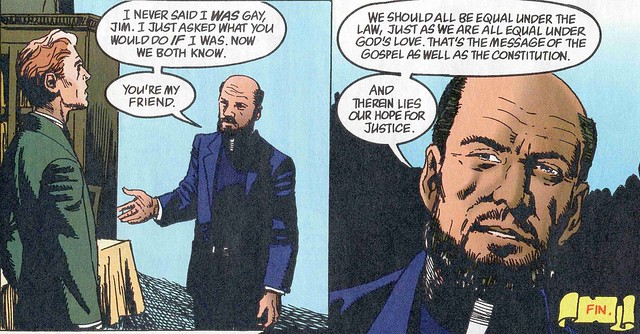
The following year, the character Hero came out about his homosexuality in the pages of Superboy and the Ravers #13. Supergirl (vol. 4) #10 introduced readers to Andy Jones — an angel made up of a man and a woman…it’s very reminiscent of Cloud only without having Andy’s attraction to Supergirl have any impact whatsoever on their gender presentation at any given time, which makes a lot more sense. (That’s Linda Danvers Supergirl not Kara Zor-El Supergirl…you know what? It’s a little confusing.) And the two did eventually have a relationship, albeit fairly short lived. Andy’s recurring appearances would score Supergirl a GLAAD Award for Outstanding Comic in 1999 — the fourth time DC won that award.

It seems like as soon as the Code said it was okay to do, DC was like “here’s all these queer issues we want to talk about, and a whole bunch of queer characters!” And they just went for it for most of the 90s. A big part of that can probably be credited to Neal Pozner, who was the Creative Director for DC Comics for a time and who was an HIV-positive gay man. He died from AIDS complications in 1994, and his romantic partner Phil Jiminez, who was a writer and artist for DC, began penning the miniseries Tempest shortly afterwards. It was based around Aqualad, a character Pozner had created a new costume for when he was writing Aquaman in the 80’s. At the end of the fourth issue of Tempest, which was published in 1997, Jiminez included an editorial in which he dedicated the miniseries to Pozner and publicly came out as a gay man — believed to be the first time a creator came out in the pages of a comic book. DC received over 150 supportive letters in response. Jiminez has gone on to great success since then and is arguably one of the more important comic book creators of the Modern Age.

Other openly gay creators, such as Maurice Vellekoop, began getting serious recognition for their work, even outside of underground circles. Drawn & Quarterly, one of the largest and most successful comic book publishing companies in Canada, collected a decade’s worth of Vellekoop’s works and published them in a book entitled Vellevision: A Cocktail of Comics and Pictures in November of 1997.
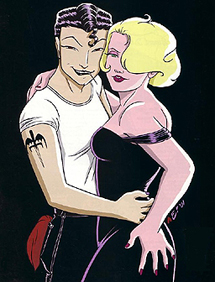
That was the same year that Disney animator Elizabeth Watasin debuted her character Magical Witch Girl Bunny in Action Girl Comics #13. Only a few years later, that character would be leading her own series called Charm School — of which nine issues have been published, and a tenth is currently on the way. Meanwhile, Andy Mangels and Michael A. Martin attempted to another franchise lagging in queer representation into the future by introducing the lesbian character Etana Kol into Star Trek: Deep Space Nine #10 — a comic book series created by Marvel Comics to tell additional adventures based on the TV series. I’m a big Trekkie myself, so let me tell you: it’s really a shame that these comic books aren’t considered canon because there wouldn’t be an actual lesbian in actual canon Star Trek for another 22 years. That’s another post I’m probably going to write at some point…

In 1998, Mangels and Martin introduced a gay man named Yoshi Mishima to Star Trek in Marvel’s Star Trek: Starfleet Academy #17 — still not canon, still about 18 years before actual Star Trek would have its first actual gay man. But a good effort all the same. Other than that 1998 mostly saw our representation in underground comics like Havoc Inc. — a comedic sci-fi adventure series starring Chester Magreer and Chris Deck, a gay couple who operate a space freighter business together with their adopted daughter. The series ran for nine issues, ending in 2001. The comic strips “Troy” (by Michael Derry) and “Chelsea Boys” (by Glenn Hanson) — both of which would end up published in various gay newspapers and magazines — both launched that year as well.
The following year seemed like it would be much the same — mostly queer artists telling queer stories in underground and alternative comic books. Julian Lake‘s cartoons were released in a collection called Guess Who’s Coming Out at Dinner, Samuel Delaney published an autobiographical graphic novel called Bread and Wine: An Erotic Tale of New York, Jennifer Camper put out the first strips of “Subgurlz.” And then San Diego Comic Con International happened — the first edition of Out in Comics, a guide to the work of LGBTQ+ comic creators, was released by Andy Mangels and an ashcan edition of Gay Force Quarterly appeared at the convention as well, creating quite a stir (until no finished issues were ever released. Oops.)

But even that paled in comparison to what would happen in December when DC, under their WildStorm imprint (which they had just acquired), released The Authority #8, wherein it was revealed that Midnighter and Apollo — basically the Batman and Superman of that comic universe, who’d been fairly central characters in two series for the past year — were a couple. (And when I say “revealed” I really mean “confirmed for people who really can’t read between the lines” — they were naked in a bedroom together in their very first ever scene, for crying out loud.) There was nothing truly “first” or groundbreaking about them — two white male superheroes being gay together. What made it important was that they were already so important. And they’d be even more important in the coming decades….
…..which we’ll talk about in the conclusion!







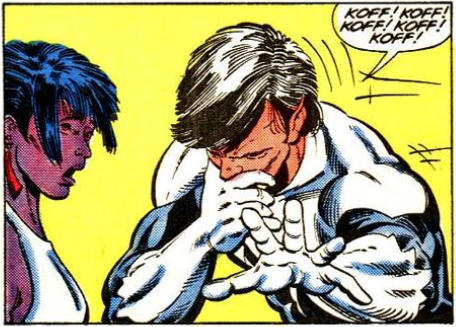
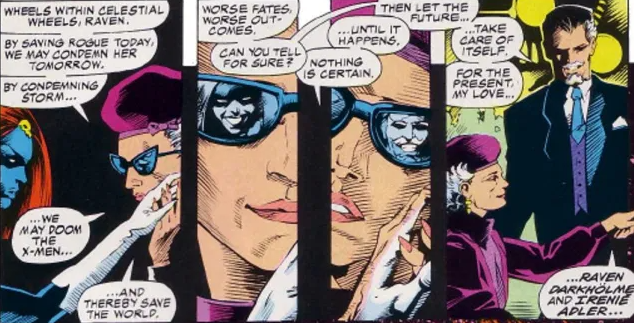
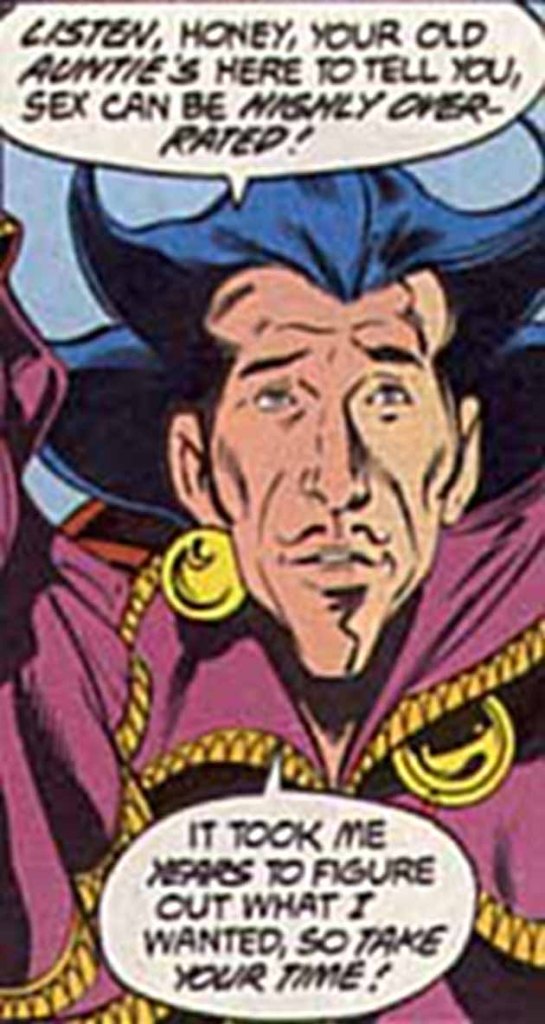

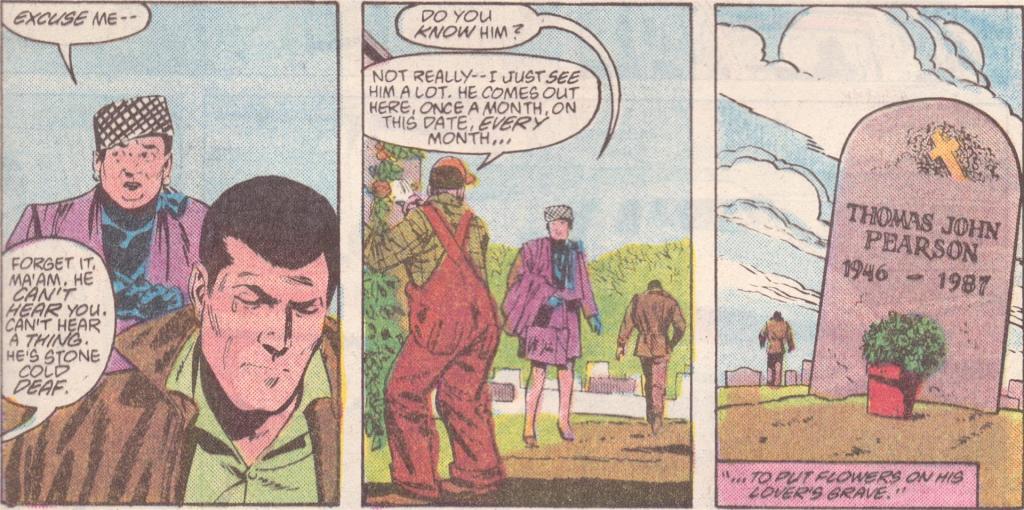




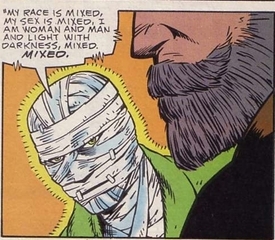






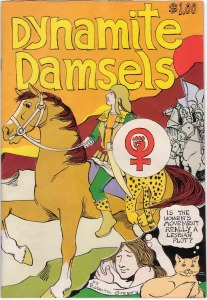






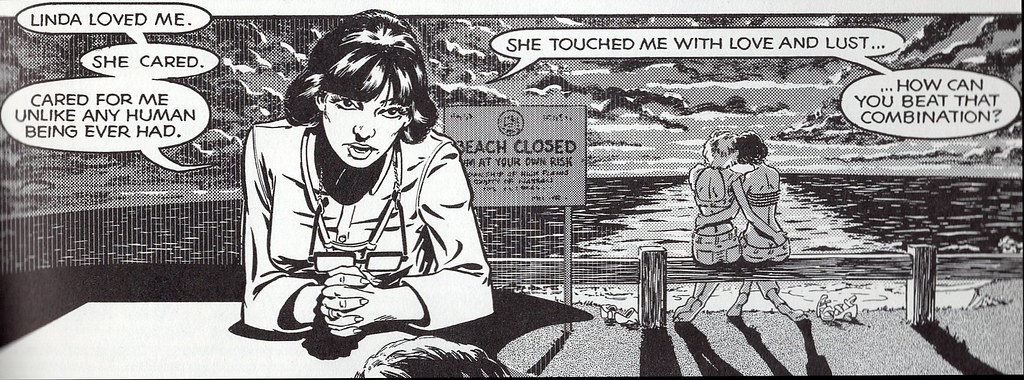

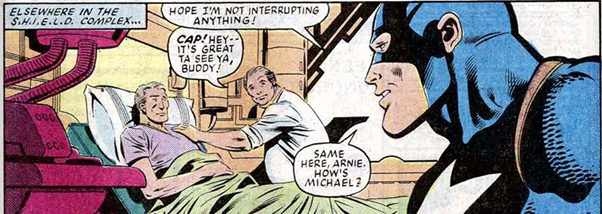



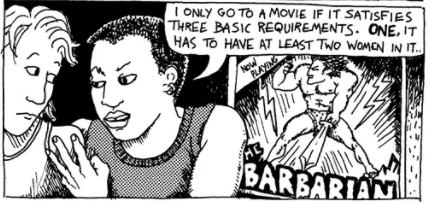
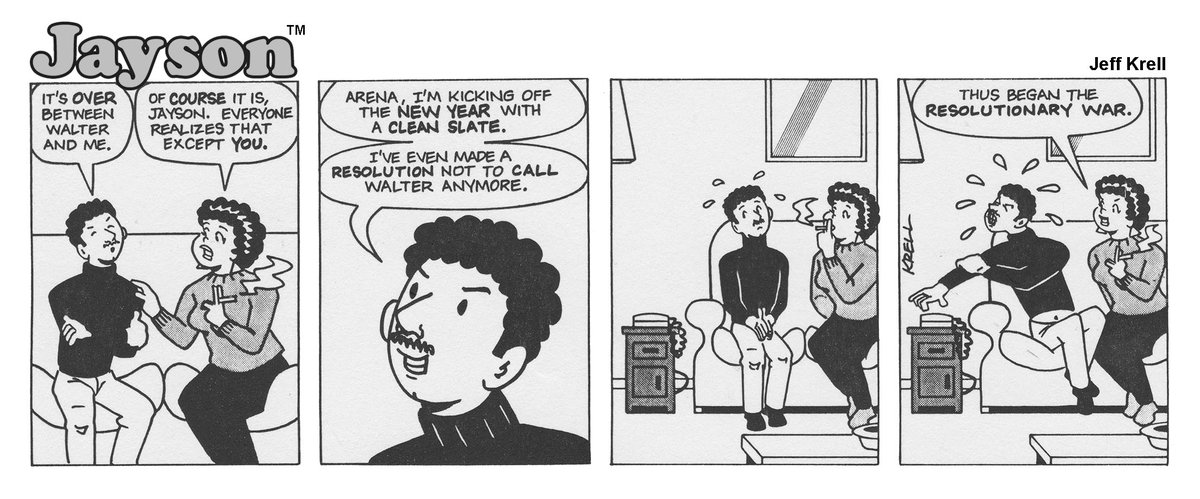




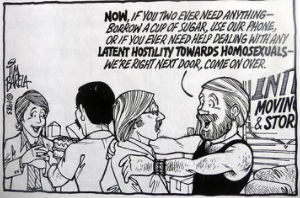
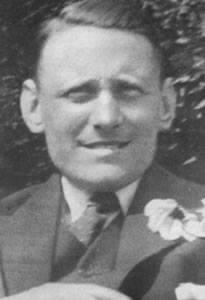
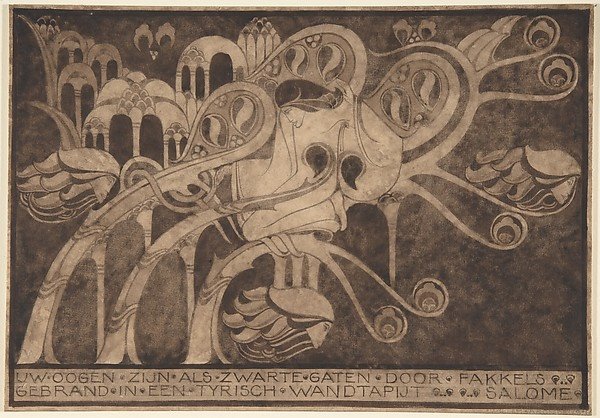
 Arguably, the oldest depictions of homosexuality are the Grotta dell’Addaura (or the Addaura Cave) in Sicily. These particular images are estimated to date back to somewhere roughly between 9,600 and 5,000 BCE. The area had already been studied by paleontologists, because there’d been remains of a dwarf elephant nearby but in 1943 Allied forces invaded the island. They decided to store ammunition in some of the caves near Palermo. Some of the ammunition being stored in this particular cave exploded — revealing previously buried rock art. Obviously, there was a war going on and a recent explosion of valuable ammo, so studying the rock art wasn’t an immediate priority. Nevertheless, Jole Bovio Marconi studied the rock art extensively and published her findings in 1953 CE. The particular drawing of note in this cave — which Marconi herself believed was a homoerotic image — shows a circle of people around two men who are arching their backs. It’s been argued this isn’t actually an image of gay sex (and — again — it’s a little hard to tell but if it is, it seems kind of, I dunno, kinky?) Some people say it’s an image of hunters hunting (hunting what?) or of a religious ceremony, or possibly of acrobats. I honestly couldn’t tell you but that’s why I included a picture of it. I sort of see seals but what do I know, really?
Arguably, the oldest depictions of homosexuality are the Grotta dell’Addaura (or the Addaura Cave) in Sicily. These particular images are estimated to date back to somewhere roughly between 9,600 and 5,000 BCE. The area had already been studied by paleontologists, because there’d been remains of a dwarf elephant nearby but in 1943 Allied forces invaded the island. They decided to store ammunition in some of the caves near Palermo. Some of the ammunition being stored in this particular cave exploded — revealing previously buried rock art. Obviously, there was a war going on and a recent explosion of valuable ammo, so studying the rock art wasn’t an immediate priority. Nevertheless, Jole Bovio Marconi studied the rock art extensively and published her findings in 1953 CE. The particular drawing of note in this cave — which Marconi herself believed was a homoerotic image — shows a circle of people around two men who are arching their backs. It’s been argued this isn’t actually an image of gay sex (and — again — it’s a little hard to tell but if it is, it seems kind of, I dunno, kinky?) Some people say it’s an image of hunters hunting (hunting what?) or of a religious ceremony, or possibly of acrobats. I honestly couldn’t tell you but that’s why I included a picture of it. I sort of see seals but what do I know, really?